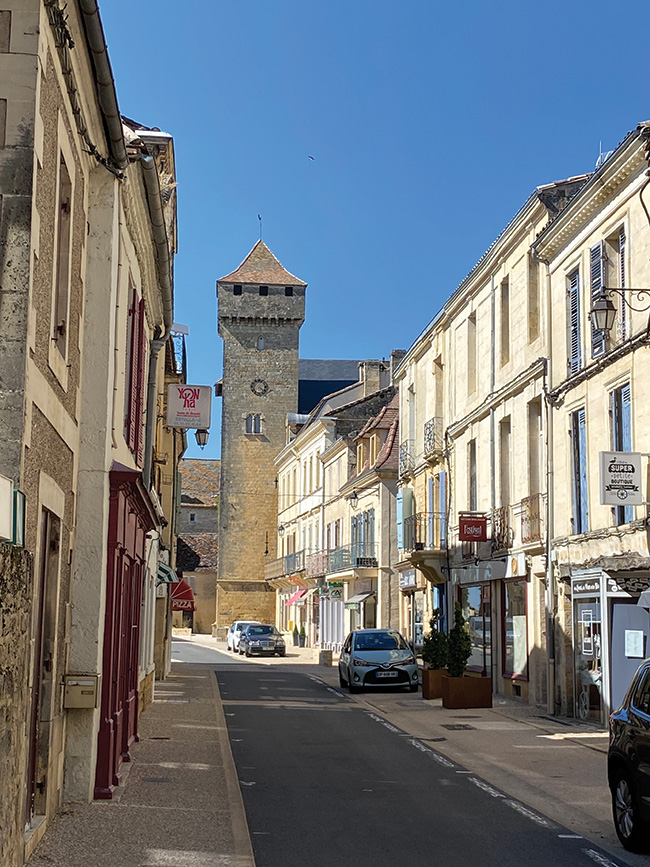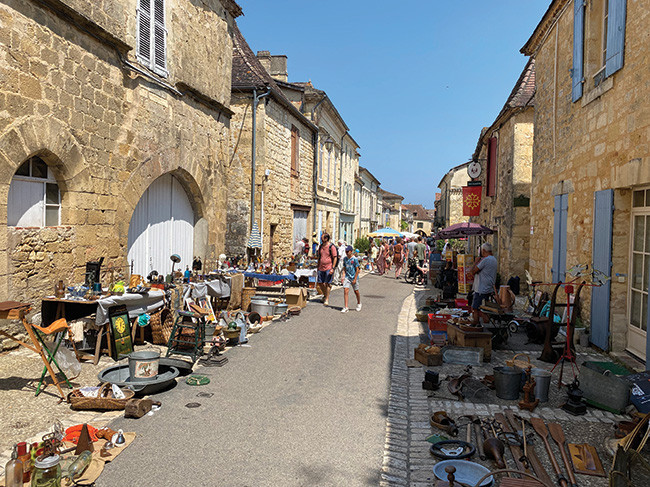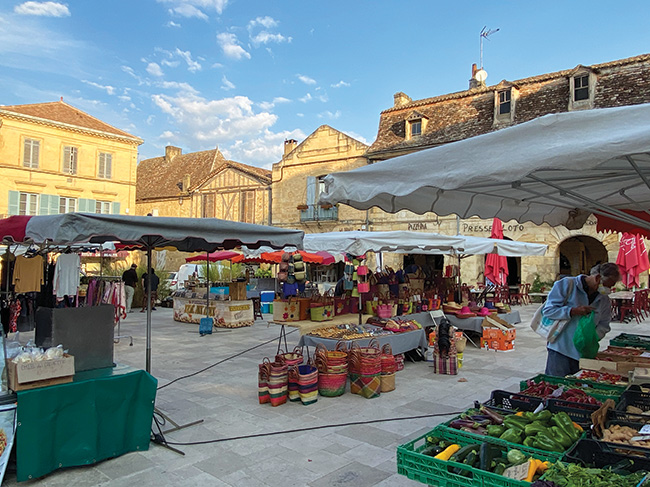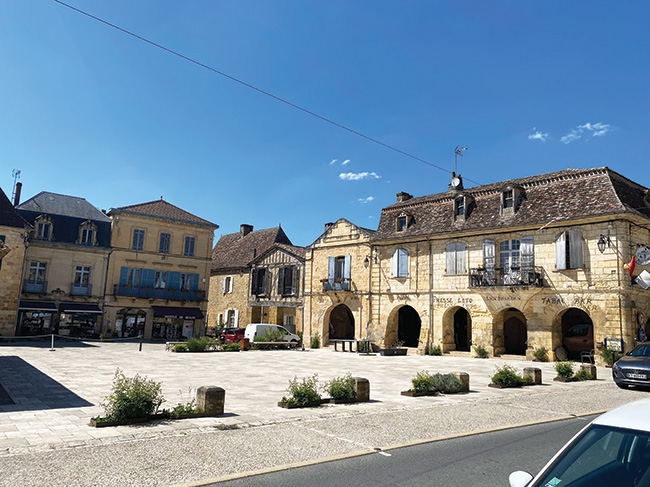Beaumont-du-Périgord: A Historic Dordogne Town

Peter Friend traces the history of the Dordogne bastide he calls home, which recently celebrated its 750th anniversary.
On July 16 this year, the royal bastide village of Beaumont-du-Périgord, in the Dordogne, celebrated its 750th anniversary. Founded by King Edward I, the 19th great grandfather of Queen Elizabeth II, Beaumont, as with much of the Dordogne, retains its English connections. As part of its expat community, we were this year able to celebrate both the Queen’s Platinum Jubilee and the 1272 foundations of our village, a fitting double-celebration of our royal ties. However, the Dordogne, as with much of France, was not always a scene of peace and tranquillity, and to understand what led to the construction of villages such as Beaumont, we need to delve into the annals of history.

Enjoy a relaxing meal in the bastide’s central square © Pays de Bergerac Office du Tourisme
During the Middle Ages, war ravaged much of France. A bitter conflict, lasting 100 years, had taken place between the royal dynasties ruling the country, headed by Plantagenet King Henry III from England and the Capetian Louis IX of France. The 1259 Treaty of Paris sought to bring peace between the two houses by reassigning regions of France to each. The highly prized Aquitaine, which was one of the wealthiest regions in the whole of Europe at the time, was retained by Henry III.
In partnership with the local nobility, including Raymond of Toulouse who owned swathes of land in southwest France, the building of new villages began. Designed to settle and house rural populations, as well as mark the territory of the respective kings, the ‘bastide’ villages were built under charters which gave legal rights and subsidies to the local population who had helped form and build these new communities. The bastides, very much the new towns of their day, were built to provide housing, shelter and refuge, places of worship and centres of commerce. The central squares were a hive of activity, where crops and animals raised and grazed on the surrounding countryside were traded in covered market places, called ‘halles’, much like Britain’s corn exchanges.

The characterful town from above © Pays de Bergerac Tourisme
The bastide villages were built within fortified defensive walls, with a grid system of narrow streets feeding out from the main central square, where the wealthy merchants and families lived. The poorer workers and their families lived out of sight, along the much narrower and darker streets, which ran parallel. Rumour has it the poor were not even permitted to walk into the central square. Edward instructed that the grid system for Beaumont be constructed in an ‘H’ pattern in homage to his father, Henry. Two main thoroughfares, either side of the main square, ran north to south, with various narrow alleys crossing east to west.

The plan setting out the Beaumont-du-Périgord’s grid architecture © Pays de Bergerac Tourisme
Five defensive towers, four on each corner and a central tower, together with 16 stone entry gates formed the outer defensive walls of Beaumont. Inside the village, the central square had ‘arcades’ (vaulted buildings) on three sides, where merchants and the wealthier classes lived above their business premises. In 1380, ramparts were constructed inside the fortified outer walls to help with the village’s defences; these were designed, should they be needed, to play an important role during the Hundred Years War (1337-1453). Today, only one tower (Tour de Bannes) and one of the gates (Porte de Luziers) remain.

A side street leading to the Église Saint-Front © Pays de Bergerac Tourisme
As Beaumont had no château (usually an important defensive feature around which bastide villages were built) the construction of the imposing Saint-Front church also commenced in 1272. This landmark building dominates both Beaumont and the surrounding countryside for many miles around. It was of a fortified Gothic design and became a Monument Historique in 1909. The Église Saint-Front was not only a place of worship, but it also played a key role in the security of the village as it incorporated high defensive towers, from which unwanted invaders could be spotted and slain by arrows. Furthermore, it provided a place of shelter: its enormous interior could house villagers and their livestock when under attack and two wells provided fresh water for as long as the siege may last.

Tthe flambeaux, a torch-lit walk around the village every Thursday in July and August © OT Bastides Dordogne Périgord
Whilst, like much of France, Beaumont and its Saint-Front Church were Catholic, the village was taken by Protestants in 1576, 1585 and 1587, without force nor destruction. Even during the Hundred Years War, Beaumont survived pretty much unscathed and was neither ransacked nor demolished. The aforementioned towers and gateways were only removed in the 18th century, making way for the expansion of the village’s housing. We might never know how far Edward had planned to expand his series of bastides in the region but many of these villages in the Dordogne, and in neighbouring Lot-et-Garonne, can be attributed to period of construction during the Middle Ages, under the reigns of both French and English royalty.

The popular brocante or antiques fair © Pays de Bergerac Office du Tourisme
Most notably, Monpazier, just 15 minutes from Beaumont, was built in 1284 and is widely regarded as one of the best examples of a bastide village in southwest France. Molières (1284) is only 10 minutes away and Lalinde (1267) is 15 minutes away. These were all built by the English.
Within 30 minutes, the French-built bastide villages include Monflanquin (1256), Villeréal (1265) and Eymet (1270). Each has its own distinct charms and all are certainly worth visiting, whether staying in the region or passing through.
Some 750 years since the founding stones of Beaumont were laid, it is amazing to wander the streets of the village and marvel at the beautifully preserved architecture of its buildings, which were built using locally-quarried stone. The central square still plays the same role today as it did all those centuries before – a place of commerce where markets take place, as well as being a focal point for community events. Blacksmiths, fletchers and farriers may have been replaced by boutique shops, bistros and bars, but the village’s heart and soul remains.

Pick up fresh, local produce at the market and head for a picnic in the stunning countryside surrounding Beaumont-du-Périgord © Pays de Bergerac Office du Tourisme
All year round, Tuesday is market day, with the number of stalls swelling four-fold in the warmer summer months. This is when the central square comes alive from 8am until 1pm with fresh regional produce, gourmet foods and gifts. Round off your shopping trip with a lazy lunch in a village restaurant, or pick up items for a picnic on a walk in the surrounding countryside.
Every Wednesday from late June until early September, a fantastic brocante (antiques fair) takes place, spilling out from the central square along the two main streets of the village. And on Thursday evenings you can relive the history of Beaumont when members of the local Office du Tourisme dress in medieval costume and guide you on a walking tour by candlelight – a fascinating stroll back through time which is great for all ages and starts at 9pm during July and August.
On Monday and Friday evenings from June through to late September, the Café des Art’Cades organises apéro concerts, an eclectic mix of music with spontaneous dancing in the square, together with various delicious food offerings. As the village turns 750, we hope many reading this article will visit our medieval streets to soak up the many centuries of history and imagine those early days of village life.

The town’s central square where the wealthy used to live © Pays de Bergerac Tourisme
Beaumont Essentials
For more information about Beaumont and the surrounding bastide villages, visit the Pays de Bergerac Tourism website. www.pays-bergerac-tourisme.com/en
You can also visit the tourist office in person (located within the post office in the village square) where the helpful, multilingual staff can pass on their wealth of information, and from where you can pick up walking tours and leaflets for the raft of great places to see within a short distance of the village.
Author Peter Friend who, with his partner Mark, lives in the village, runs a prestigious new chambres d’hôtes. www.dordognebandb.com
From France Today magazine.
Lead photo credit : Beaumont-du- Périgord is 750 years old © Déclic & Décolle
Share to: Facebook Twitter LinkedIn Email
More in bastide villages, Beaumont-du-Périgord, Dordogne, history of the Dordogne, most beautiful towns in the Dordogne
By Peter Friend
Leave a reply
Your email address will not be published. Required fields are marked *




REPLY